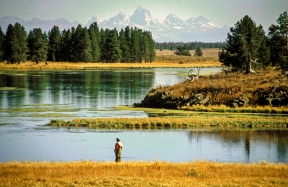
What Happened in 2016
I have heard the term, “the perfect storm” with regard to the reasons for the poor fishing encountered during the 2016. There may be a better term to evaluate what happened but the term fits pretty well.
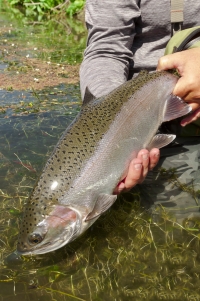
Snowpack. As late as early March, our snowpack was promising. Holding the snowpack until later in the spring is like having the best storage reservoir in the entire watershed. As with a manmade reservoir, the longer the water can be held in storage, the better it is later on. March was like pulling the plug in the bathtub. Warm temperatures and rain quickly melted our snow sending the water downstream at least 3 weeks earlier than normal.
Fall River. The lack of snow in the Fall River drainage came home to roost on the Henry’s Fork later in June. Fall River is often in flood stage in late May and early June which helps provide enough natural flow to meet irrigation demands without calling for storage water from Island Park. This year it was just a trickle at the highway 20 bridge.
Irrigation demand. Our early spring brought farmers into their fields to plant crops earlier than normal. With most of the natural flow already gone, the call for storage water came early. On June 13 the flow on the graph was just above 500 cfs, too low for great fishing on the Ranch. A day later it bumped up to about 900 cfs, perfect for Ranch fishing. Unfortunately it didn’t last long. On June 20 it ramped up again over 1100 cfs, again on June 22 to 1300 cfs and peaked on June 28 to 1600 cfs. The average flow from Island Park usually stays under 1000 cfs until about the 2nd week of July.
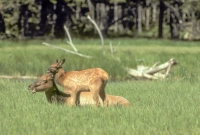
Dry summer. Our climate is very dry but usually we get a bit of rain and cloudy weather during the course of the summer. Not in 2016. Ashton received just 0.69 inches of rain in June, July and August, compared with an average of 3.2 inches. As recently as 2014, Ashton received 4.6 inches of rain during the summer. The dry weather put more pressure on irrigation demand and it didn’t help the fishing.
Water rented from Palisades. I realize that this is very difficult to understand due to Idaho’s complex water laws. Groundwater users rented 20,000 acre feet of water in Palisades but it was delivered to managed recharge sites in the Henry’s Fork. This was delivered from mid-July until the end of the season.
Low inflow. I have never heard any of the self-proclaimed Ranch experts talk about inflow. Much of the water that flows into the Island Park Reservoir and below comes from natural flow. The Henry’s Fork is known as one of the largest spring creeks in the world for good reason. Lots of water comes from groundwater flow that depends on snowpack over previous years. In 2016 the natural flow was the lowest on since 1937. Couple with that, 2014, 2015 and 2016 had the lowest cumulative inflow since 1936, 1937, and 1938.
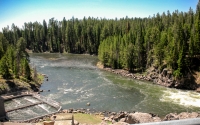
Turbid water. Most of the disgruntlement resulted from dirty water. Fortunately most of this was organic material in the form of algae. Part of the reason the water was more turbid than usual was the hydro facility at the Island Park Dam was off-line for part of the season. The water usually runs much clearer when it comes through the turbines. I won’t get into the details of this. Melissa Muradian’s blog of July 19 on the Henry’s Fork Foundation’s webpage explains this in great detail.
Looking out for the fishery below the Fun Farm. During the summer months flows below 1000 cfs at St. Anthony elevate the water temperature and create additional stress on the trout. The goal with cooperation from the irrigators is to keep 1000 cfs at St. Anthony during the summer months. With the hot, dry summer additional pressure to divert water resulted in higher flows at Island Park in an effort to sustain the fishery below the Fun Farm.
All of the points I’ve listed are documented with solid scientific data. While some have scoffed at the perfect storm scenario, I’m open to a better term. I’ve fished the ranch for more than 55 years and I’ve had a business here for over 40 years. I have never seen a year with so many negative influences on the Ranch fishing.
What We Know
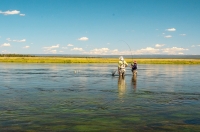
The trout population below the Island Park Dam is directly correlated to winter flows. Higher flows increase survival of young-of-the-year trout. The 2014 season produced some of the best fishing I’ve had in a long time in the Ranch. The fishing dropped off a bit in 2015 but was still pretty good. It’s easy to see why when looking at the USGS graphs. The average winter flow in 2012 from Island Park was about 600 cfs. It was above 400 cfs in the winter of 2013. It dropped to 200+ cfs in 2014 and hasn’t been above 300 cfs since. Population estimates in the Box Canyon have dropped from more than 6000/mile in 2013 to 2265/mile in 2016. It is important to note that 2265/mile is still pretty good and not far below the target objectives of the Idaho Department of Fish and Game.
In the 1970s and early 1980s stocked fish and trout flushed downstream from the Island Park Reservoir augmented the trout population in the Box Canyon and the Ranch. There is a direct correlation between significant draw-downs of the reservoir and the trout population. For example, the trout population was well over 4000/mile in the two years following the draw-down of 1992.
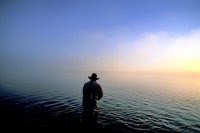
Sediment transport out of the reservoir is greater when the reservoir is lower. There is a threshold at about 40,000 acre-feet, but the real high transport occurs below 10,000 acre feet. In 1992 the reservoir was drafted to 237 acre feet. In 1979 it went to 430 acre feet and in 2003 it was 11,997 acre feet. I am not aware of sediment release estimates for 1979 but one estimate was 90,000 tons of sediment released in 1992. In my opinion a lot more sediment was released in 1992 as a result of the fires of 1988 which released a tremendous amount of sediment into the Henry’s Fork above the reservoir. Much of this sediment is still evident today.
Aquatic insects do best in clean gravel. There is not a lot of baseline data over the past 4 decades with regard to overall abundance of aquatic insects. However a recent study conducted by the Henry’s Fork Foundation in 2015-2016 indicates that overall, the abundance of all macroinvertebrates averages about 47,000 individuals per square meter of stream bottom which is pretty good. Keep in mind that these are not all aquatic insects of interest to anglers. Worms, mollusks, leeches, crustaceans, etc. are included in the group. Among other things this research indicates that the presence of most species of mayflies, caddisflies and stoneflies was greatest at Flatrock, Last Chance and Ashton.
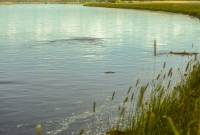
Trout move to seek out the most suitable habitat. In low gradient streams like the Ranch the available habitat includes depth, velocity, cover from aquatic vegetation, and substrate size. Detailed habitat surveys indicate that aquatic vegetation increases cover throughout the summer. Rainbow trout also prefer greater depths. Water depth increases when the abundance of aquatic vegetation is high.
Water is colder and has more oxygen but is less clear when it is delivered through the old dam gates rather than the power plant during the summer. Most of the material that discolors the water during the middle of the summer is organic matter.
What We Don't Know
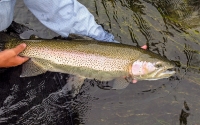
It is not possible to make solid population estimates of trout in the Ranch. The techniques used to electro-fish the Box Canyon and other areas of the river will not work in the Ranch. The nature of the slow, shallow water enables trout to quickly sense the electrical field and shy away. We can only assume that the population estimates of the Box Canyon correlate to the Ranch.
What happens to trout with higher flows? We know that higher water is good for trout because the water is cooler and provides more velocity and depth. Do trout move into the Ranch from the Box Canyon when the summer flows are up?
Some of the aquatic insects, especially caddisflies do not appear to be as prolific as they once were. Caddisflies, especially the genus Hydropsyche or Spotted Sedge is the most important caddis hatch of the summer on many trout streams. Their larvae are net-makers which require clean gravel with interstitial spaces where they can build their tiny nets to filter their food. In the late 1970s there were literally clouds of them in the evenings at Last Chance. Are they now less prevalent because of sediment?
Conclusion
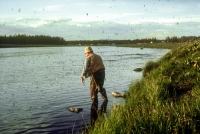
While there is still plenty we don’t know, we know a heck of a lot more than we did in 1984 when I was a part of the initial organization of the Henry’s Fork Foundation. With so much information available I have little tolerance for those who continue to choose to ignore all of the available scientific data resulting from all of the research that has been done by Dr. Rob Van Kirk and his team with the Henry’s Fork Foundation. Back in the 1970s and early 1980s about all we had to go on was based on our own experience and the opinion of others. It is amazing to me today how some, especially some very experienced and prominent anglers, have not moved beyond the 1970s and continue to rely solely on their own experience or the opinions of other Ranch experts. I am reminded of a poster of the portrait of an English Bull Dog. It stated “My mind’s made up, don’t confuse me with the facts!”
The number of hours per trout you catch and what fly you caught them on has little relevance to what is really going on. For example, we know that in the Ranch trout seek out the most suitable habitat. They also feed where and when their food is most available. Why would they try to feed on the surface when the higher turbid water provides ample habitat and, in all likelihood, plenty of available subsurface food? Just because you don’t see trout doesn’t mean they aren’t there.
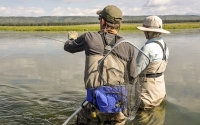
Even though our guide clients were catching some very good fish, I didn’t fish the Ranch at all in late July and August knowing how tough it would be to find feeding fish. I don’t like blind fishing, especially in the Ranch. In my mind, blind fishing isn’t the Ranch way. There were plenty of other places to find rising fish and fish the Ranch way. I heard things had picked up in September and I was pleasantly surprised to find good numbers of big trout feeding on Mahogany Duns when I finally fished the Ranch. We actually ran more guided trips in the Ranch in 2016 than in 2015 and our success rates were comparable. However much of it was blind fishing with hoppers from the boat in July and August but our clients caught good numbers of large trout. The good fish were there but they just weren’t rising.
Don’t get me wrong. I can’t argue that the number of trout in the Ranch was down in 2016. The available data told us what to expect when we met with Henry’s Fork Foundation staff before the Ranch opened. Low winter flows and a lower population count in the Box Canyon told us what to expect. We knew we might be in for some tough sledding.
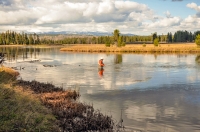
More importantly, by the end of May the realization and potential for disaster began to hit home. It’s one thing to have tough fishing but potential damage to this precious resource is of far greater concern. Remember, with 40 years in business this isn’t my first rodeo. The worst year I’ve ever had in business correlated with the worst fishing season I’ve ever witnessed in the Ranch. 1979 was similar to last season with a very low snowpack and early irrigation demand. By early August the flow was up to 2400 cfs. If you weren’t happy with 1600 cfs last season you should give 2400 cfs a try. By the middle of the month the dam was belching turbid water. It continued to worsen until the very bowels of the reservoir were dumped into the Box Canyon leaving the reservoir with only 430 acre feet. The dam was completely shut off on October 2 and remained shut off until December 3. When the gates were finally opened the flow was minimal throughout the winter.
If not for the Henry’s Fork Foundation I firmly believe that 2016 would have been a repeat of 1979. I was deeply troubled when I heard some of the Ranch Regulars place much of the blame for their poor fishing squarely on the Henry’s Fork Foundation. It was said that the “gentlemen’s agreement” between the irrigators and the Henry’s Fork Foundation had been violated. What gentlemen’s agreement? There is no gentlemen’s agreement and there never has been a gentlemen’s agreement. All of the water laws in Idaho favor the irrigators who own the storage water in the reservoir.
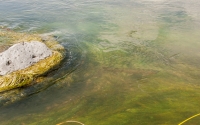
Drought management planning was required by federal legislation in 2003. The final plan was signed by the irrigators, Nature Conservancy, Trout Unlimited, the Bureau of Reclamation, and the Henry’s Fork Foundation in 2005. There is no guaranteed flow and no “gentlemen’s agreement.” The only legal requirement is that the parties meet to discuss operations. It is unlikely that the Drought Management Plan would make a difference if not for all of the clear cut data regarding the river and the fishery collected by the Henry’s Fork Foundation. I remember the days when the irrigators wouldn’t talk to us. It took at least a dozen years to gain this trust.
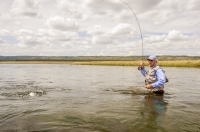
Late last summer I was fortunate to be included in a very significant Drought Management meeting. Our greatest concern was to avoid a repeat of 1979. All indications were for the reservoir to be drawn down to less than 10,000 acre feet creating another significant sediment flush. I couldn’t believe how all parties at the table were focused on this issue. Even more amazing was that we (HFF) actually had a seat at the table. While it may not be important to the Ranch Regulars, the fishery is significant from the Fun Farm downstream. However, by late August the water temperature was not as critical and it was determined that the St. Anthony flow objective could be lowered from 1000 cfs to 850 cfs. Implementing this change saved at least 10,000 acre feet in the reservoir. It also resulted in winter flows that have averaged 167 cfs this winter versus 124 cfs last winter and 80 cfs that was predicted earlier in August.
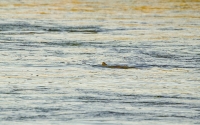
No one can argue that the fishing wasn’t tough on the Ranch in 2016. However, it is unlikely that there were long term damaging effects to the fishery. It could and would have been much worse if not for the Henry’s Fork Foundation. My suggestion is instead of trying to put blame on an organization that has done nothing but help to avoid disaster, you write them a note of appreciation and don’t forget to include a check.
This has turned out to be one of the longest blogs I have ever written and I haven’t begun to discuss what is being done to help avoid another 2016 in the future. There are some exciting things to cover. Look for this in my next blog.